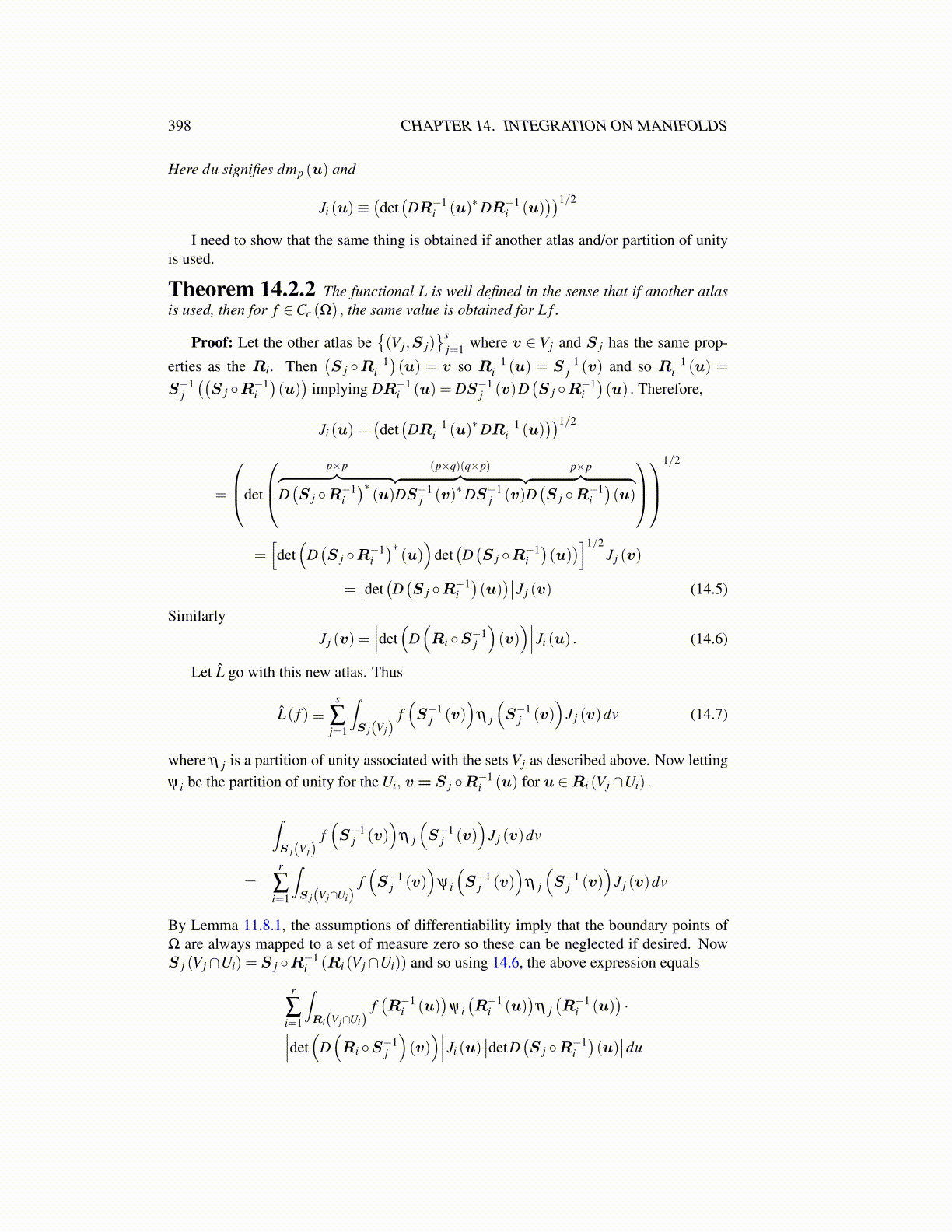
398 CHAPTER 14. INTEGRATION ON MANIFOLDS
Here du signifies dmp (u) and
Ji (u)≡(det(DR−1
i (u)∗DR−1i (u)
))1/2
I need to show that the same thing is obtained if another atlas and/or partition of unityis used.
Theorem 14.2.2 The functional L is well defined in the sense that if another atlasis used, then for f ∈Cc (Ω) , the same value is obtained for L f .
Proof: Let the other atlas be{(Vj,S j)
}sj=1 where v ∈ Vj and S j has the same prop-
erties as the Ri. Then(S j ◦R−1
i
)(u) = v so R−1
i (u) = S−1j (v) and so R−1
i (u) =
S−1j
((S j ◦R−1
i
)(u))
implying DR−1i (u) = DS−1
j (v)D(S j ◦R−1
i
)(u) . Therefore,
Ji (u) =(det(DR−1
i (u)∗DR−1i (u)
))1/2
=
det
p×p︷ ︸︸ ︷
D(S j ◦R−1
i)∗(u)
(p×q)(q×p)︷ ︸︸ ︷DS−1
j (v)∗DS−1j (v)
p×p︷ ︸︸ ︷D(S j ◦R−1
i)(u)
1/2
=[det(
D(S j ◦R−1
i)∗(u))
det(D(S j ◦R−1
i)(u))]1/2
J j (v)
=∣∣det
(D(S j ◦R−1
i)(u))∣∣J j (v) (14.5)
SimilarlyJ j (v) =
∣∣∣det(
D(Ri ◦S−1
j
)(v))∣∣∣Ji (u) . (14.6)
Let L̂ go with this new atlas. Thus
L̂( f )≡s
∑j=1
∫S j(V j)
f(S−1
j (v))
η j
(S−1
j (v))
J j (v)dv (14.7)
where η j is a partition of unity associated with the sets Vj as described above. Now lettingψ i be the partition of unity for the Ui, v= S j ◦R−1
i (u) for u ∈Ri (Vj ∩Ui) .
∫S j(V j)
f(S−1
j (v))
η j
(S−1
j (v))
J j (v)dv
=r
∑i=1
∫S j(V j∩Ui)
f(S−1
j (v))
ψ i
(S−1
j (v))
η j
(S−1
j (v))
J j (v)dv
By Lemma 11.8.1, the assumptions of differentiability imply that the boundary points ofΩ are always mapped to a set of measure zero so these can be neglected if desired. NowS j (Vj ∩Ui) = S j ◦R−1
i (Ri (Vj ∩Ui)) and so using 14.6, the above expression equals
r
∑i=1
∫Ri(V j∩Ui)
f(R−1
i (u))
ψ i(R−1
i (u))
η j(R−1
i (u))·∣∣∣det
(D(Ri ◦S−1
j
)(v))∣∣∣Ji (u)
∣∣detD(S j ◦R−1
i)(u)∣∣du